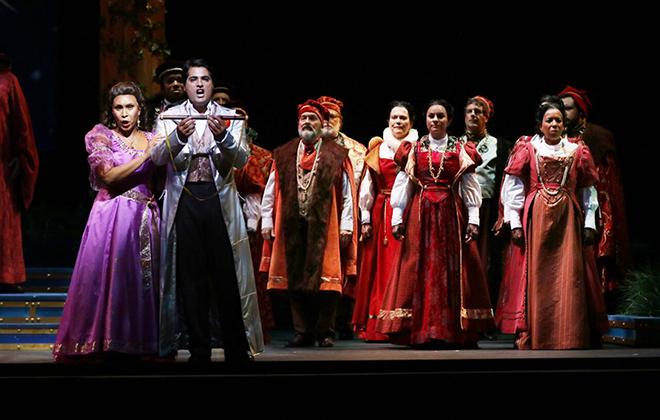From this week’s TGIF Cover Story by Steven Mark.
Great music has the ability to transcend time and space.
Mozart’s “The Magic Flute,” which premiered nearly 225 years ago, not only has music that remains beloved over those two-plus centuries, but it also has a story that seems to fit seamlessly into any era. It is simply a fairy tale, which Hawaii Opera Theatre’s production emphasizes with an art-inspired presentation that frames the story as a series of pictures.
“It’s very beautiful, with images that are from paintings of Magritte,” said director Allison Grant. “They kind of resonate with you. You may not know what it’s from, but you think, ‘Oh, I recognize that.'”
Rene Magritte was a 20th-century Belgian artist whose witty surrealist paintings placed everyday items in unusual contexts. His images commonly contain objects that suggest the idea of a portal to another world, such as doors, windows and picture frames. “It’s all about going through picture frames, going to different dimensions,” Grant said.
Given that setting, this staging of “The Magic Flute” has a handsome prince, Tamino, suddenly appearing in an alien land as if by magic, not knowing how or why he got there, where is immediately threatened by a monster.
Tamino gets a sidekick, the comical bird catcher Papageno, and a heroic task, saving the life of Pamina, the kidnapped daughter of the Queen of the Night, along with a magic flute that can tame the wildest threat with its soothing melodies.
Though Mozart originally set the story in Egypt, some say the story is a reference to the secret Masonic rituals — the hero Tamino must pass tests of fire and water to win Pamina — while others say it shows a misogynist streak in Mozart, as its women are portrayed as being deceitful or untrustworthy.
YOU DON’T need to make quantum leaps into a world of arcane Victorian values or exotic customs to enjoy “The Magic Flute,” though.
Antonio Figueroa, a French-Canadian tenor who has portrayed Tamino on a nationwide tour of one production and is making his HOT debut in the role here, sees “many layers” to the story. He doesn’t see the opera as critical of women.
“If you look at the music, all the most beautiful music is going to the women: Pamina, the Queen of the Night,” he said. “You have melody, which is feminine, and rhythm, which is masculine, and Mozart was a genius of melody.”
Figueroa sees Tamino as “the guy in search of truth.”
“For me this story is about the journey of everybody in life,” he said. “When you look at the guy who has the wider consciousness, you look to Tamino.”
RETURNING TO HOT after a hilarious turn in “The Mikado” two years ago is Curt Olds as Papageno, whom he calls the buffoonish “Everyman” of the opera.
“I’m sort of the character that the audience steps through,” Olds said. “There’s princes and princesses that they relate to, too, but having that presence of Papageno in the piece let’s them think, ‘I can see myself there, too’ in this journey of morals and reaching for those things we all desire in life.”
Olds especially enjoys the role of Papageno because it requires a lot of acting. “The Magic Flute” is a “Singspiel” (singing play) containing a lot of spoken dialogue.
The performance will be in English, so the audience can instantly connect with the wordplay, but that won’t make it any easier on the cast.
“It’s not the singing that makes you tired; it’s the spoken dialogue,” Olds said. “We tend to ‘fall off’ our breath when we’re speaking, because we speak in life, and you don’t support it the same way you do when you’re singing.”
“THE MAGIC FLUTE” offers plenty of enjoyable singing as well, particularly the vocal gymnastics of the famous Act 2 aria “Hell’s Vengeance,” in which the Queen of the Night implores her daughter to commit murder.
South Korean soprano So Young Park, who makes her HOT debut in this demanding role, says it requires stamina and preparation to consistently hit its top note, a high F.
“I have to plan it from the beginning; that’s just for one note,” she said, adding that the note helps her to feel the emotion of the moment, because “when you’re angry your voice gets higher.”
Park also has a major aria in Act 1, “Tremble not, my dear son,” which presents other challenges. “It starts with a really lyric, warm sound, and it turns to that evil side, with a lot of coloratura, so it’s kind of harder for me than the second aria.”
While the queen’s character has that ambiguity, there’s little of that with her co-conspirator, Monostatos, who is driven by lust but constrained by duty.
Portraying the role is Julius Ahn, who got his start in opera with the HOT chorus and now performs throughout the mainland and Canada. He too enjoys the acting aspect of the role, getting to be “the rascal out on stage.”
“He’s very primal. He’s driven by his desires, which he doesn’t get to have because he’s in a temple,” Ahn said. “He’s serving purity and light and fulfillment, and he doesn’t get to fulfill any of these primal desires he has as a man.”
HOT’s production was developed by Arizona Opera and was created by Daniel Rigazzi of the Metropolitan Opera. References to Magritte’s paintings are littered throughout the play, from costuming that ranges from steampunk to Elizabethan and props like the scooterlike skateboards that are ridden by three child-spirits who help Tamino and Papageno.
That all is in the service of a story and music so powerful that they’ve made “The Magic Flute” one of the most popular works in the opera repertoire.
“For me it’s more about the humanity of each character and how it touches us and how it touches the truth in each one of us,” Grant said. “But I really believe that the music really touches us and helps us find the divine within ourselves. It’s really uplifting music and it really hits the soul.”


